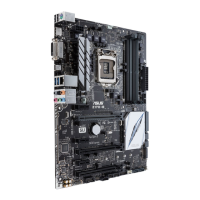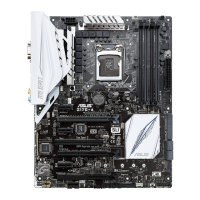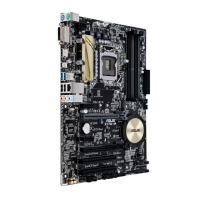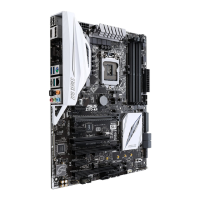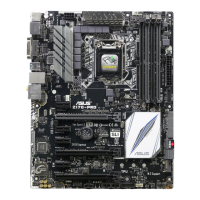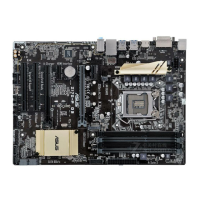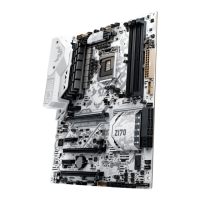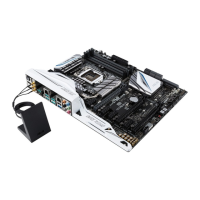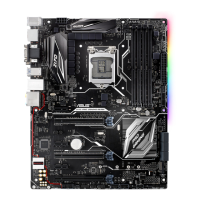Do you have a question about the Asus Z170-WS and is the answer not in the manual?
Highlights key features of the motherboard and new technology supported.
Details features exclusive to ASUS workstations, like CrossFireX and Q-Code Logger.
Describes special features such as DTS Connect and ErP Ready for energy efficiency.
Provides a general overview of the motherboard and its components.
Illustrates the physical layout of the motherboard components and connectors.
Details the LGA1151 socket and CPU installation guidelines.
Explains the DDR4 DIMM slots and memory installation.
Describes the PCI Express slots and their configurations.
Details the functionality of onboard buttons like Power-on and Reset.
Explains the purpose and configuration of motherboard jumpers.
Describes the POST State LEDs and other diagnostic LEDs on the motherboard.
Details various internal connectors like SATA, M.2, and headers for fans and front panel.
Guides through the physical assembly of PC components onto the motherboard.
Steps for installing the motherboard into the PC chassis.
Procedure for installing the CPU into the LGA1151 socket.
Instructions for mounting the CPU cooler and fan.
Guide to installing RAM modules into the DIMM slots.
Explains how to connect the ATX power supply cables.
Details connecting SATA hard drives and SSDs.
How to connect front panel connectors for USB, audio, and LEDs.
Steps for installing expansion cards like graphics cards.
Information on updating the system BIOS using various utilities.
Overview of rear panel I/O ports and audio connections.
Steps to follow for the initial power-on and POST sequence.
Instructions on how to properly shut down or put the system to sleep.
Introduction to the ASUS UEFI BIOS interface and its purpose.
How to enter and navigate the BIOS setup utility.
Overview of the simplified EZ Mode for basic BIOS configuration.
Introduction to the Advanced Mode for detailed BIOS settings.
Description of the main menu items available in the BIOS.
Configuration of fan speeds and profiles for CPU and chassis fans.
Utilizing the wizard for automatic CPU/DRAM overclocking and RAID setup.
Personalizing the BIOS screen by saving favorite items.
Overview of system information and basic settings in the Main menu.
Configuration options related to overclocking and system performance tuning.
Detailed settings for CPU, system devices, and platform features.
Displays system temperatures, voltages, and fan speeds.
Options for configuring system boot behavior and device priority.
Settings for compatibility support, including boot device control and secure boot.
Access to utilities like EZ Flash, Secure Erase, and Overclocking Profile.
Options to load defaults, save, or discard changes and exit BIOS.
Instructions and utilities for updating the motherboard BIOS.
Guides on installing operating systems, focusing on Windows 7 with USB 3.0 drivers.
Information about the contents and usage of the support DVD.
General information about software applications provided on the support DVD.
Introduction to ASUS AI Suite 3 and its integrated utilities.
Details Realtek HD Audio Manager and DTS Studio Sound features.
Overview of supported RAID levels (0, 1, 5, 10).
Steps for installing SATA hard disks for RAID configuration.
Enabling RAID functionality within the BIOS Setup.
Accessing and using the Intel RST Option ROM utility for RAID management.
Step-by-step guide to creating a RAID volume using the utility.
Procedure for removing an existing RAID set.
Methods for creating a RAID driver disk.
Loading RAID drivers during the OS installation process.
Installation and configuration for AMD CrossFireX multi-GPU setups.
Installation and configuration for NVIDIA SLI multi-GPU setups.
Visual representation of the motherboard's internal architecture and connections.
Important regulatory notices, including FCC compliance statements.
Information regarding chemical compliance and product disposal.
License terms for Google software components used in the product.
Contact details for ASUS technical support and service centers.
Highlights key features of the motherboard and new technology supported.
Details features exclusive to ASUS workstations, like CrossFireX and Q-Code Logger.
Describes special features such as DTS Connect and ErP Ready for energy efficiency.
Provides a general overview of the motherboard and its components.
Illustrates the physical layout of the motherboard components and connectors.
Details the LGA1151 socket and CPU installation guidelines.
Explains the DDR4 DIMM slots and memory installation.
Describes the PCI Express slots and their configurations.
Details the functionality of onboard buttons like Power-on and Reset.
Explains the purpose and configuration of motherboard jumpers.
Describes the POST State LEDs and other diagnostic LEDs on the motherboard.
Details various internal connectors like SATA, M.2, and headers for fans and front panel.
Guides through the physical assembly of PC components onto the motherboard.
Steps for installing the motherboard into the PC chassis.
Procedure for installing the CPU into the LGA1151 socket.
Instructions for mounting the CPU cooler and fan.
Guide to installing RAM modules into the DIMM slots.
Explains how to connect the ATX power supply cables.
Details connecting SATA hard drives and SSDs.
How to connect front panel connectors for USB, audio, and LEDs.
Steps for installing expansion cards like graphics cards.
Information on updating the system BIOS using various utilities.
Overview of rear panel I/O ports and audio connections.
Steps to follow for the initial power-on and POST sequence.
Instructions on how to properly shut down or put the system to sleep.
Introduction to the ASUS UEFI BIOS interface and its purpose.
How to enter and navigate the BIOS setup utility.
Overview of the simplified EZ Mode for basic BIOS configuration.
Introduction to the Advanced Mode for detailed BIOS settings.
Description of the main menu items available in the BIOS.
Configuration of fan speeds and profiles for CPU and chassis fans.
Utilizing the wizard for automatic CPU/DRAM overclocking and RAID setup.
Personalizing the BIOS screen by saving favorite items.
Overview of system information and basic settings in the Main menu.
Configuration options related to overclocking and system performance tuning.
Detailed settings for CPU, system devices, and platform features.
Displays system temperatures, voltages, and fan speeds.
Options for configuring system boot behavior and device priority.
Settings for compatibility support, including boot device control and secure boot.
Access to utilities like EZ Flash, Secure Erase, and Overclocking Profile.
Options to load defaults, save, or discard changes and exit BIOS.
Instructions and utilities for updating the motherboard BIOS.
Guides on installing operating systems, focusing on Windows 7 with USB 3.0 drivers.
Information about the contents and usage of the support DVD.
General information about software applications provided on the support DVD.
Introduction to ASUS AI Suite 3 and its integrated utilities.
Details Realtek HD Audio Manager and DTS Studio Sound features.
Overview of supported RAID levels (0, 1, 5, 10).
Steps for installing SATA hard disks for RAID configuration.
Enabling RAID functionality within the BIOS Setup.
Accessing and using the Intel RST Option ROM utility for RAID management.
Step-by-step guide to creating a RAID volume using the utility.
Procedure for removing an existing RAID set.
Methods for creating a RAID driver disk.
Loading RAID drivers during the OS installation process.
Installation and configuration for AMD CrossFireX multi-GPU setups.
Installation and configuration for NVIDIA SLI multi-GPU setups.
Visual representation of the motherboard's internal architecture and connections.
Important regulatory notices, including FCC compliance statements.
Information regarding chemical compliance and product disposal.
License terms for Google software components used in the product.
Contact details for ASUS technical support and service centers.
| Socket | LGA 1151 |
|---|---|
| Chipset | Intel Z170 |
| Form Factor | ATX |
| Memory Slots | 4 |
| Maximum Memory | 64 GB |
| PCIe 3.0 x16 Slots | 4 |
| Audio | Realtek ALC1150 |
| Storage Interface | 6 x SATA 6Gb/s |
| M.2 Slots | 1 |
| USB 3.1 (Gen2) | 2 |
| USB 3.0 (Gen1) | 4 |
| USB 2.0 | 6 |
| RAID Support | RAID 0, 1, 5, 10 |
